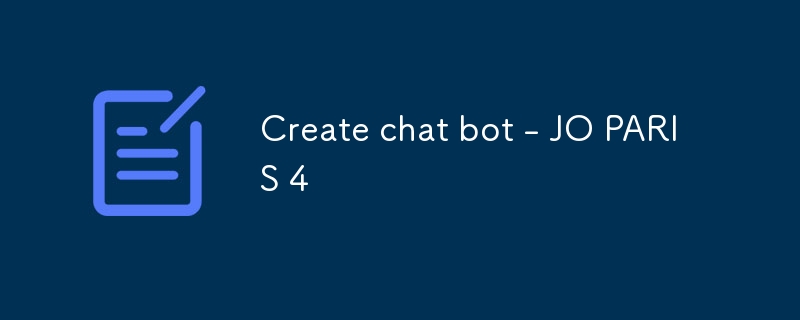

In this article, I show how to create a simple chat bot with tensorflow.
For the data, I use a kaggle dataset from PARIS JO JO 2024 to get sentences at the training stage.
You can obtain the finish code in my github : https://github.com/victordalet/Kaggle_analysis/tree/feat/paris_2024_olympics
A tensorflow dataset on chat bots looks like this.
We can find a tag, a pattern and the various responses.
Our goal will be to add the different sequences from the JO betting dataset and add them to a file like this.
{ "intents": [ { "tag": "google", "patterns": [ "google", "search", "internet" ], "responses": [ "Redirecting to Google..." ] },
I read a chat bot dataset in default json and JO's csv and split and processed it to add the sentence in the json
import json class CreateDataset: def __init__(self): self.json_path = 'data.json' self.csv_path = '../paris-2024-faq.csv' with open(self.json_path) as file: self.dataset = json.load(file) f = open(self.csv_path, 'r') dataset_split = f.read().split(";") question = False for data in dataset_split: if question: question = False self.dataset["intents"][-1]["responses"].append(data) if "?" in data: question = True self.dataset["intents"].append({ "tag": "", "patterns": [ data ], "responses": [ ] }) with open(self.json_path, 'w') as f: json.dump(self.dataset, f)
For training purposes, I've edited a tensorflow example.
If you take my code to run it, add in the first argument the number of epochs you want.
Create a save directory where your model will go, and add inside the classes.pkl and words.pkl files that are in the github like at the beginning of this article.
import random import json import pickle import numpy as np import sys import nltk from nltk.stem import WordNetLemmatizer from tensorflow.keras.models import Sequential from tensorflow.keras.layers import Dense, Dropout from tensorflow.keras.optimizers import SGD class Train: words: list classes: list documents: list ignore_letters: list training: list output_empty: list train_x: list train_y: list model: Sequential epochs: int def __init__(self): self.lemmatizer = WordNetLemmatizer() self.intents = json.loads(open('data.json').read()) self.words = [] self.classes = [] self.documents = [] self.training = [] self.ignore_letters = ['?', '!'] self.epochs = int(sys.argv[1]) def run(self): self.download_nltk_data() self.load_training_data() self.prepare_training_data() self.build_neural_network() self.train() @staticmethod def download_nltk_data(): nltk.download('punkt') nltk.download('wordnet') def load_training_data(self): for intent in self.intents['intents']: for pattern in intent['patterns']: word_list = nltk.word_tokenize(pattern) self.words.extend(word_list) self.documents.append((word_list, intent['tag'])) if intent['tag'] not in self.classes: self.classes.append(intent['tag']) def prepare_training_data(self): self.words = [self.lemmatizer.lemmatize(word) for word in self.words if word not in self.ignore_letters] self.words = sorted(set(self.words)) self.classes = sorted(set(self.classes)) pickle.dump(self.words, open('saves/words.pkl', 'wb')) pickle.dump(self.classes, open('saves/classes.pkl', 'wb')) self.output_empty = [0] * len(self.classes) for document in self.documents: bag = [] word_patterns = document[0] word_patterns = [self.lemmatizer.lemmatize(word.lower()) for word in word_patterns] for word in self.words: bag.append(1) if word in word_patterns else bag.append(0) output_row = list(self.output_empty) output_row[self.classes.index(document[1])] = 1 self.training.append([bag, output_row]) random.shuffle(self.training) self.training = np.array(self.training) self.train_x = list(self.training[:, 0]) self.train_y = list(self.training[:, 1]) def build_neural_network(self): self.model = Sequential() self.model.add(Dense(128, input_shape=(len(self.train_x[0]),), activation='relu')) self.model.add(Dropout(0.5)) self.model.add(Dense(64, activation='relu')) self.model.add(Dropout(0.5)) self.model.add(Dense(len(self.train_y[0]), activation='softmax')) sgd = SGD(lr=0.01, momentum=0.9, nesterov=True) self.model.compile(loss='categorical_crossentropy', optimizer=sgd, metrics=['accuracy']) def train(self): self.model.fit(np.array(self.train_x), np.array(self.train_y), epochs=self.epochs, batch_size=5, verbose=1) self.model.save('saves/chatbot_model.model') if __name__ == "__main__": Train().run()
I create a ChatBot class, with a test method that takes a random message.
You can use the get_response method to add this chatbot to your application, for example I call it in one of my projects in a flask api to have my chatbot in a website.
import random import json import pickle import numpy as np import nltk from nltk.stem import WordNetLemmatizer from tensorflow.keras.models import load_model class ChatBot: lemmatizer: WordNetLemmatizer intents: dict words: list classes: list model: load_model ERROR_THRESHOLD = 0.25 def __init__(self): self.download_nltk_data() self.lemmatizer = WordNetLemmatizer() self.intents = json.loads(open('data.json').read()) self.words = pickle.load(open('saves/words.pkl', 'rb')) self.classes = pickle.load(open('saves/classes.pkl', 'rb')) self.model = load_model('saves/chatbot_model.model') @staticmethod def download_nltk_data(): nltk.download('punkt') nltk.download('wordnet') def clean_up_sentence(self, sentence): sentence_words = nltk.word_tokenize(sentence) sentence_words = [self.lemmatizer.lemmatize(word) for word in sentence_words] return sentence_words def bag_of_words(self, sentence): sentence_words = self.clean_up_sentence(sentence) bag = [0] * len(self.words) for w in sentence_words: for i, word in enumerate(self.words): if word == w: bag[i] = 1 return np.array(bag) def predict_class(self, sentence): bow = self.bag_of_words(sentence) res = self.model.predict(np.array([bow]))[0] results = [[i, r] for i, r in enumerate(res) if r > self.ERROR_THRESHOLD] results.sort(key=lambda x: x[1], reverse=True) return_list = [] for r in results: return_list.append({'intent': self.classes[r[0]], 'probability': str(r[1])}) return return_list def get_response(self, intents_list): intents_json = self.intents tag = intents_list[0]['intent'] list_of_intents = intents_json['intents'] for i in list_of_intents: if i['tag'] == tag: result = random.choice(i['responses']) break return result def test(self): while True: message = input("") ints = self.predict_class(message) res = self.get_response(ints) print(res)
The above is the detailed content of Create chat bot - JO PARIS 4. For more information, please follow other related articles on the PHP Chinese website!




